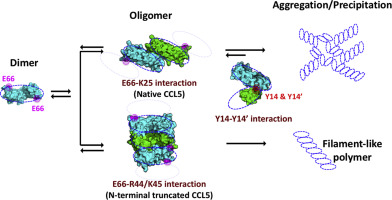当前位置:
X-MOL 学术
›
J. Mol. Biol.
›
论文详情
Our official English website, www.x-mol.net, welcomes your feedback! (Note: you will need to create a separate account there.)
Integrative Model to Coordinate the Oligomerization and Aggregation Mechanisms of CCL5.
Journal of Molecular Biology ( IF 5.6 ) Pub Date : 2020-01-10 , DOI: 10.1016/j.jmb.2019.12.049 Yi-Chen Chen,Siou-Pei Chen,Jin-Ye Li,Pei-Chun Chen,Yi-Zong Lee,Kun-Mou Li,Raz Zarivach,Yuh-Ju Sun,Shih-Che Sue
Journal of Molecular Biology ( IF 5.6 ) Pub Date : 2020-01-10 , DOI: 10.1016/j.jmb.2019.12.049 Yi-Chen Chen,Siou-Pei Chen,Jin-Ye Li,Pei-Chun Chen,Yi-Zong Lee,Kun-Mou Li,Raz Zarivach,Yuh-Ju Sun,Shih-Che Sue

|
CC-type chemokine ligand 5 (CCL5) is involved in the pathogenesis of many inflammatory conditions. Under physiological conditions, CCL5 oligomerization and aggregation are considered to be responsible for its inflammatory properties. The structural basis of CCL5 oligomerization remains controversial because the current oligomer models contain no consensus interactions. In this study, NMR and biophysical analyses proposed evidence that the CC-type CCL5 dimer acts as the basic unit to constitute the oligomer and that CCL5 oligomerizes alternatively through E66-K25 and E66-R44/K45 interactions. In addition, a newly determined trimer structure, constituted by CCL5 and the E66S mutant, reported an interfacial interaction through the N-terminal 12FAY14 sequence. The interaction contributes to CCL5 aggregation and precipitation but not to oligomerization. In accordance with the observations, an integrative model explains the CCL5 oligomerization and aggregation mechanism in which CCL5 assembly consists of two types of dimer-dimer interactions and one aggregation mechanism. For full-length CCL5, the molecular accumulation triggers oligomerization through the E66-K25 and E66-R44/K45 interactions, and the 12FAY14 interaction acts as a secondary effect to derive aggregation and precipitation. In contrast, the E66-R44/K45 interaction might dominate in CCL5 N-terminal truncations, and the interaction would lead to the filament-like formation in solution.
中文翻译:

整合模型,以协调CCL5的低聚和聚集机理。
CC型趋化因子配体5(CCL5)参与了许多炎症性疾病的发病机制。在生理条件下,CCL5的低聚和聚集被认为是其炎症特性的原因。CCL5寡聚化的结构基础仍存在争议,因为当前的寡聚体模型不包含共有相互作用。在这项研究中,NMR和生物物理分析提出了证据,表明CC型CCL5二聚体充当组成低聚物的基本单元,并且CCL5通过E66-K25和E66-R44 / K45相互作用交替低聚。此外,由CCL5和E66S突变体组成的新确定的三聚体结构报告了通过N端12FAY14序列的界面相互作用。相互作用有助于CCL5的聚集和沉淀,但不会导致低聚。根据观察结果,整合模型解释了CCL5的低聚和聚集机制,其中CCL5组装由两种类型的二聚体-二聚体相互作用和一种聚集机制组成。对于全长CCL5,分子积累通过E66-K25和E66-R44 / K45相互作用触发寡聚,而12FAY14相互作用则是引发聚集和沉淀的次要作用。相反,E66-R44 / K45相互作用可能在CCL5 N端截短中占主导地位,并且相互作用将导致溶液中形成丝状。分子积累通过E66-K25和E66-R44 / K45相互作用触发低聚,而12FAY14相互作用则是引发聚集和沉淀的次要作用。相反,E66-R44 / K45相互作用可能在CCL5 N端截短中占主导地位,并且相互作用将导致溶液中形成丝状。分子积累通过E66-K25和E66-R44 / K45相互作用触发低聚,而12FAY14相互作用则是引发聚集和沉淀的次要作用。相反,E66-R44 / K45相互作用可能在CCL5 N端截短中占主导地位,并且相互作用将导致溶液中形成丝状。
更新日期:2020-01-13
中文翻译:

整合模型,以协调CCL5的低聚和聚集机理。
CC型趋化因子配体5(CCL5)参与了许多炎症性疾病的发病机制。在生理条件下,CCL5的低聚和聚集被认为是其炎症特性的原因。CCL5寡聚化的结构基础仍存在争议,因为当前的寡聚体模型不包含共有相互作用。在这项研究中,NMR和生物物理分析提出了证据,表明CC型CCL5二聚体充当组成低聚物的基本单元,并且CCL5通过E66-K25和E66-R44 / K45相互作用交替低聚。此外,由CCL5和E66S突变体组成的新确定的三聚体结构报告了通过N端12FAY14序列的界面相互作用。相互作用有助于CCL5的聚集和沉淀,但不会导致低聚。根据观察结果,整合模型解释了CCL5的低聚和聚集机制,其中CCL5组装由两种类型的二聚体-二聚体相互作用和一种聚集机制组成。对于全长CCL5,分子积累通过E66-K25和E66-R44 / K45相互作用触发寡聚,而12FAY14相互作用则是引发聚集和沉淀的次要作用。相反,E66-R44 / K45相互作用可能在CCL5 N端截短中占主导地位,并且相互作用将导致溶液中形成丝状。分子积累通过E66-K25和E66-R44 / K45相互作用触发低聚,而12FAY14相互作用则是引发聚集和沉淀的次要作用。相反,E66-R44 / K45相互作用可能在CCL5 N端截短中占主导地位,并且相互作用将导致溶液中形成丝状。分子积累通过E66-K25和E66-R44 / K45相互作用触发低聚,而12FAY14相互作用则是引发聚集和沉淀的次要作用。相反,E66-R44 / K45相互作用可能在CCL5 N端截短中占主导地位,并且相互作用将导致溶液中形成丝状。



























 京公网安备 11010802027423号
京公网安备 11010802027423号